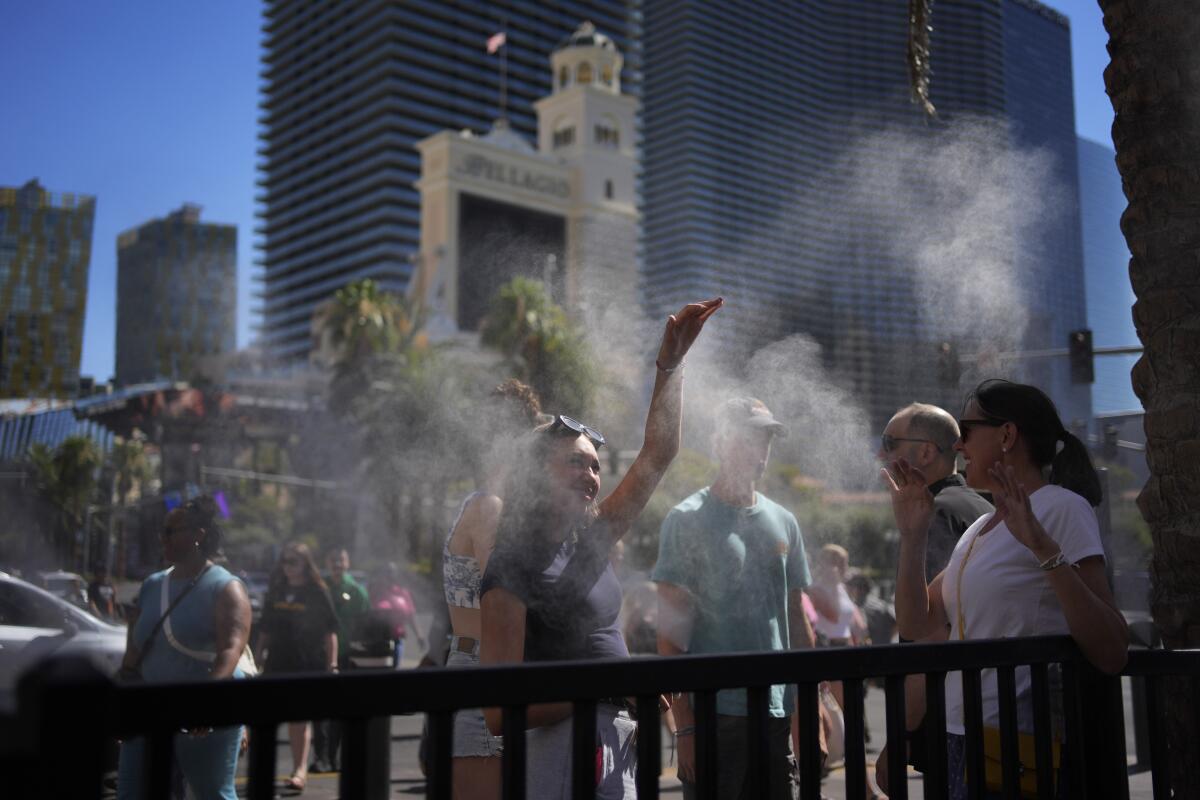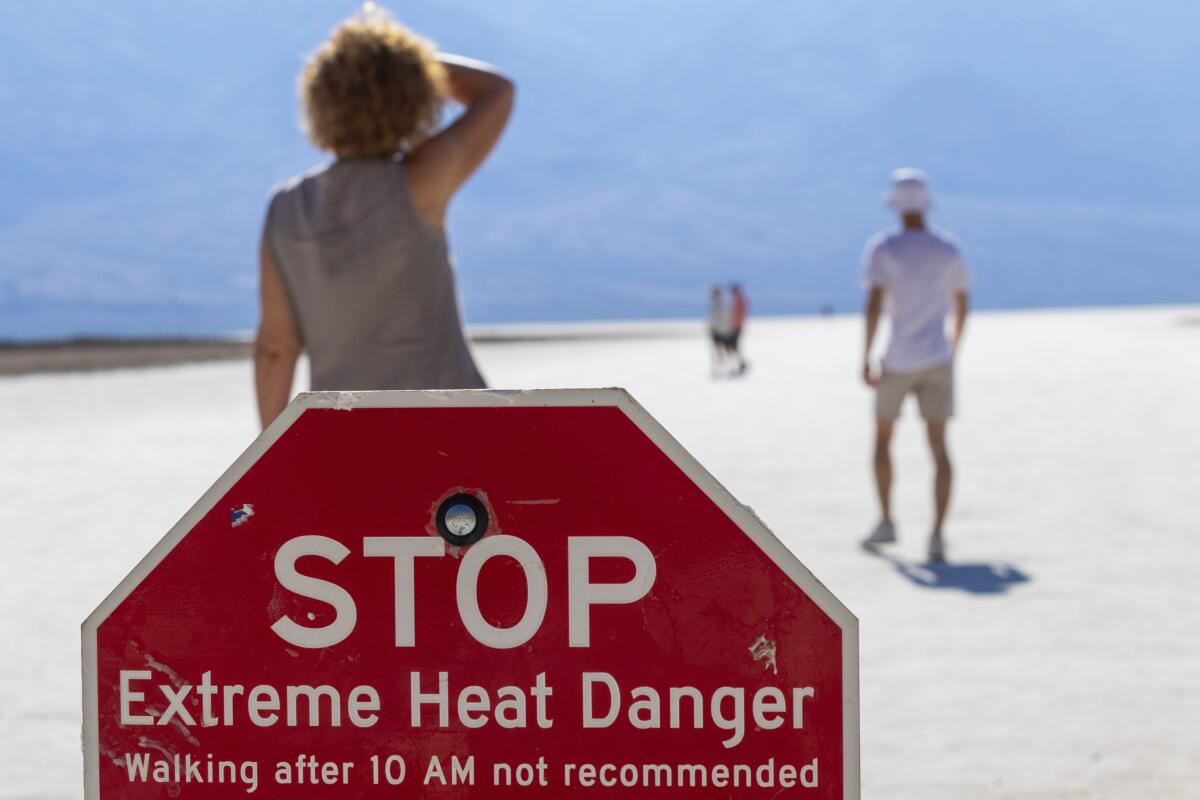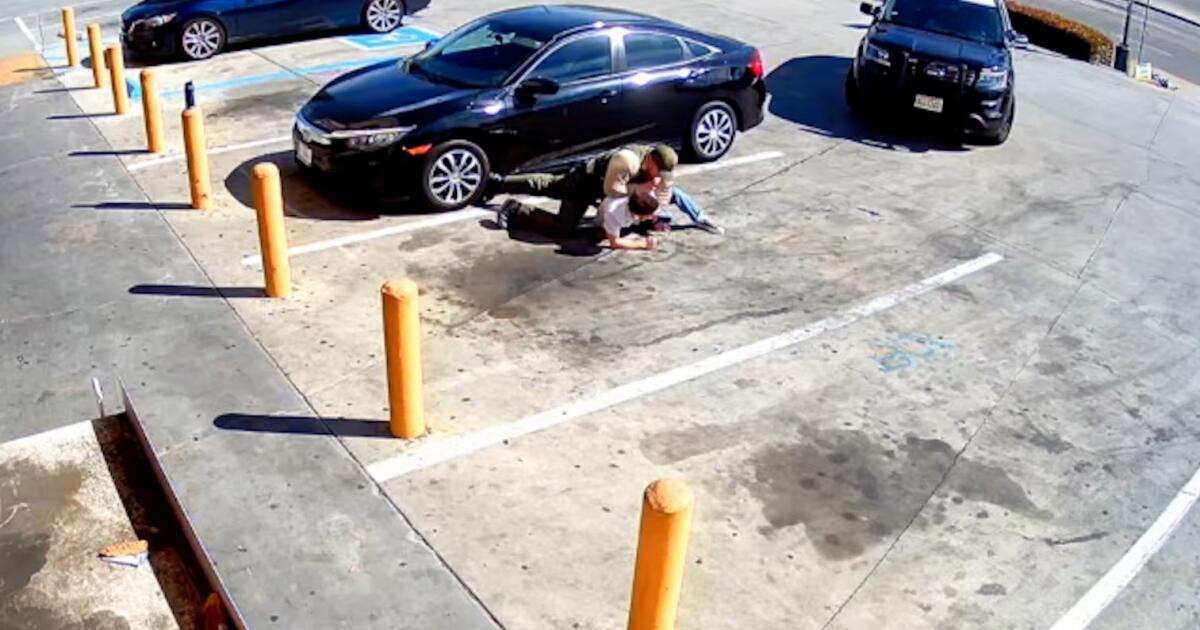The intense early-season heat wave sweeping across much of the Western United States has already set several records, but it is forecast to continue for another week, bringing triple-digit temperatures and exacerbating health and wildfire concerns in California and surrounding states.
“This is record-breaking heat, so take it very seriously,” said Dan Berc, a meteorologist with the National Weather Service in Las Vegas. “This is not normal, this is excessive heat. … We’re talking 10 to 12 degrees above normal for the hottest part of the year.”
Authorities have blamed several deaths on the intense heat. They include a motorcyclist who died Saturday in Death Valley National Park and four suspected heat-related deaths in the Portland, Oregon, area.
People jump into the Willamette River from Duckworth Pier on Friday in Portland, Oregon.
(Jenny Kane/Associated Press)
On Sunday, Las Vegas broke its all-time temperature record by three degrees, reaching 120 for the first time since record-keeping began in 1937, according to the weather service. Several records were set this weekend across California, including in the eastern deserts, Antelope Valley and the northwest part of the state.
Officials say the temperatures alone are alarming, but the number of days exceeding 100, 110 or 115 degrees is also notable and dangerous.
Much of inland California is expected to remain under an excessive heat warning through at least Friday, with many areas facing the risk of extreme heat for several days in a row, forecasts show.
The San Joaquin Valley is expected to be under an excessive heat watch for 12 days straight, starting early last week through Saturday, with weather officials warning that “this rare, long-duration level of extreme heat, with little to no overnight relief, affects everyone.”
While the Central Valley is accustomed to hot summers, health risks increase when nighttime temperatures remain high. Some areas did not record temperatures below 80 degrees this weekend.
“That could potentially be one of the longest [excessive heat warnings]“It’s the longest, if not the longest,” said Andy Bollenbacher, a meteorologist with the National Weather Service in Hanford. “This ridge of high pressure is very strong and it’s not moving anywhere.”
That ridge of high pressure, often referred to as a heat dome, is parked over the West and nothing is expected to interfere with it for days, until it begins to move slightly eastward.
“We have a very large, long-standing pressure cooker over the San Joaquin Valley, and really over all of California, keeping us very hot for a long time,” Bollenbacher said.
It's difficult to link a heat wave directly to climate change, but researchers continue to find that man-made global warming is causing more frequent and intense heat events. Recent heat waves are more likely to break records against a backdrop of warmer global temperatures, as well as increased urbanization, which is raising baseline temperatures, Berc said.
“We’ve had long-duration heat waves, but to have this combined with the magnitude of the heat … is unprecedented,” said Mike Wofford, a meteorologist with the National Weather Service in Oxnard.
In Southern California, Palmdale and Lancaster on Sunday set records for the most consecutive days with temperatures at or above 110 degrees (four), according to the National Weather Service, which has collected this data since the 1930s and 1940s. Wofford said the record for consecutive days with temperatures above 110 degrees is expected to continue this week.
High temperatures will hover around 110 degrees through Friday, according to Wofford. Lancaster also tied its all-time high temperature record of 115 degrees on Sunday.

People cool off with misters along the Las Vegas Strip on Sunday.
(John Locher/Associated Press)
Berc also said Las Vegas is expected to break all-time records for consecutive days with temperatures of 110 and 115 degrees or higher. Sin City had had four straight days with temperatures above 110 degrees as of Sunday night and is forecast to remain just as hot through early next week.
“We're looking at achieving 15 days in a row,” Berc said. “It's a record I think we're going to break.”
Temperature records were set in the Mojave Desert on Sunday, with Barstow recording 118 degrees and Bishop 111, according to the National Weather Service. Barstow-Daggett Airport also recorded a record daily low temperature on Friday, as it never dipped below 85 degrees.
High temperatures in parts of northwestern California also broke records Saturday, according to the National Weather Service’s Eureka office, with Konocti reaching 112 degrees, breaking the previous record by two degrees. Covelo reached 117, beating its previous record of 115; Alderpoint reached 113, beating the previous record of 112; and Hoopa reached 114, breaking the record by three degrees.
The rest of this week will continue to be hot across much of California, with highs expected to be 10 to 15 degrees above average for early July, Wofford said.
The deserts of eastern California are forecast to see the worst conditions through Thursday. The weather service office in Las Vegas is warning of “dangerously hot conditions for an unusually long period.” Highs in Owens Valley and Death Valley are expected to range from 105 to 129 degrees through Thursday, according to the warning.
The Sacramento Valley will remain under an excessive heat warning through Friday night, with hopes that temperatures could finally drop below 100 degrees by next weekend.
Most of southwestern California, except the coast, will remain under heat advisories through at least Thursday, with the weather service urging residents to “take action when they see symptoms of heat exhaustion and heat stroke.”
“Anyone suffering from heatstroke should be moved to a cool, shaded location,” the weather service warned. “Heat stroke is an emergency!”

A person wipes sweat from his forehead at Badwater Basin in Death Valley National Park on Sunday.
(Ty O'Neil/Associated Press)
Much of Northern California — Trinity, Mendocino, Humbolt and Lake counties — remained under an excessive heat warning as of Monday night.
Temperatures in the Pacific Northwest were also expected to remain well above average, with an excessive heat warning in effect for much of Oregon and Washington, where temperatures set records this weekend, climbing into the 90s and 100s.
The National Weather Service warns that this heat wave will continue to generate “elevated to critical fire weather conditions” in the interior, fueling “significant fire growth” for new or existing fires.
The latest fast-growing blaze, in the Los Padres National Forest in Santa Barbara County, surpassed 50,000 acres on Monday. The Lake Fire forced evacuations and was reported 8% contained Monday morning.
Times staff writer Nathan Solis contributed to this report.












